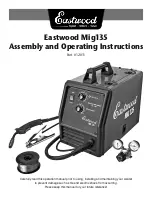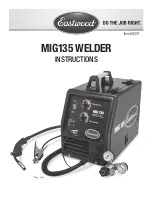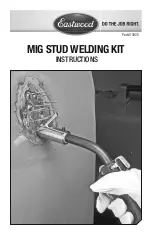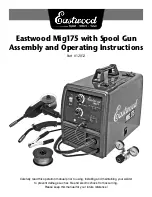
- 6 -
precise adjustment, result in excellent quality welds.
The inverter system of regulation at the power supply input (primary) also leads to a
drastic decrease in the volume of both the transformer and the levelling reactance so
that it is possible to build a considerably smaller, lighter welding machine, highlighting
its advantages of easy handling and transport.
2.2 OPTIONAL ACCESSORIES
- Argon bottle adapter.
- Welding current return cable complete with earth clamp.
- Manual remote control with 1 potentiometer.
- Manual remote control with 2 potentiometers.
- Pedal remote control.
- MMA welding kit.
- TIG welding kit.
- Self-darkening mask: with fixed or adjustable filter.
- Gas connector and pipe for hook-up with Argon bottle.
- Pressure reducing valve with gauge.
- Torch for TIG welding.
- TIG torch with potentiometer.
- G.R.A. 4500 water cooling unit.
- ARCTIC Trolley.
3. TECHNICAL DATA
3.1 DATA PLATE (FIG. A)
The most important data regarding use and performance of the welding machine are
summarised on the rating plate and have the following meaning:
1- Protection rating of the covering.
2- Symbol for power supply line:
1~: single phase alternating voltage;
3~: three phase alternating voltage.
3- Symbol
S
: indicates that welding operations may be carried out in environments
with heightened risk of electric shock (e.g. very close to large metallic volumes).
4- Symbol for welding procedure provided.
5- Symbol for internal structure of the welding machine.
6- EUROPEAN standard of reference, for safety and construction of arc welding
machines.
7- Manufacturer’s serial number for welding machine identification (indispensable for
technical assistance, requesting spare parts, discovering product origin).
8- Performance of the welding circuit:
- U
0
:
maximum no-load voltage (open welding circuit).
- I
2
/U
2
:
current and corresponding normalised voltage that the welding machine
can supply during welding.
- X :
Duty cycle: indicates the time for which the welding machine can supply
the corresponding current (same column). It is expressed as %, based on a 10
minutes cycle (e.g. 60% = 6 minutes working, 4 minutes pause, and so on).
If the usage factors (on the plate, referring to a 40°C environment) are exceeded,
the thermal safeguard will trigger (the welding machine will remain in standby
until its temperature returns within the allowed limits).
- A/V-A/V :
shows the range of adjustment for the welding current (minimum
maximum) at the corresponding arc voltage.
9- Technical specifications for power supply line:
- U
1
:
Alternating voltage and power supply frequency of welding machine (allowed
limit ±10%).
- I
1 max
:
Maximum current absorbed by the line.
- I
1 eff
:
Effective current supplied.
10-
: Size of delayed action fuses to be used to protect the power line.
11- Symbols referring to safety regulations, whose meaning is given in chapter 1
“General safety considerations for arc welding”.
Note: The data plate shown above is an example to give the meaning of the symbols
and numbers; the exact values of technical data for the welding machine in your
possession must be checked directly on the data plate of the welding machine itself.
3.2 OTHER TECHNICAL DATA
- WELDING MACHINE: see table 1 (TAB.1).
- TORCH:
see table 2 (TAB.2).
The welding machine weight is shown in table 1 (TAB. 1).
4. DESCRIPTION OF THE WELDING MACHINE
4.1 BLOCK DIAGRAM
The welding machine consists basically of power and control modules made on PCB’s
and optimised to achieve perfect reliability and reduced maintenance.
This welding machine is controlled by a microprocessor that allows a large number
of parameter settings so as to achieve perfect welding in any condition and with any
material. However, to make the best use of its properties it is necessary to be fully
aware of its possibilities.
Description (FIG. B)
1- Three-phase power supply input, rectifier unit and levelling capacitors.
2- Transistor (IGBT) switching bridge and drivers; commutes the rectified power
supply voltage to high frequency alternating voltage and adjusts the power
according to the required welding current/voltage.
3- High frequency transformer; the voltage converted by block 2 powers the primary
winding; its function is to adjust the voltage and current to the values needed for
the arc welding procedure and at the same time to form galvanic separation of the
welding circuit from the power supply line.
4- Secondary rectifier bridge with levelling inductance; commutes the alternating
voltage / current supplied by the secondary winding into very low ripple direct
current / voltage.
5- Transistor (IGBT) switching bridge and drivers; transforms the secondary output
current from DC to AC for TIG AC welding (if present).
6- Control and adjustment electronics; controls the welding current value
instantaneously and compares it with the operator’s setting; modulates the control
impulses from the IGBT drivers that make the adjustment.
7- Welding machine operation control logic; sets the welding cycles, controls the
actuators, supervises the safety systems.
8- Settings panel and display of parameters and operating modes.
9- HF strike generator (if present).
10- Protective gas solenoid valve EV.
11- Welding machine cooling fan.
12- Remote control.
4.2 CONTROL, ADJUSTMENT AND CONNECTING DEVICES
4.2.1 Rear panel (FIG. C)
1- Main switch O/OFF - I/ON.
2- Power cable (2 P + T (Single-phase)), (3 P + T (Three-phase)).
3- Coupler for connecting the gas hose (bottle - welding machine pressure reducer)
4- Fuse.
5- Connector for water cooling unit.
6- Connector for remote control:
Three different types of remote control can be connected to the welding machine
using the relative 14-pole connector at the back. Each device is recognised
automatically and can be used to adjust these parameters:
-
Remote control with one potentiometer:
rotating the potentiometer knob varies the main current from minimum to
maximum. The main current can only be adjusted with the remote control.
-
Pedal remote control:
the current value is determined by the position of the pedal. When in the TIG
2 STROKE mode, pressing the pedal starts the machine instead of pressing
the torch push-button.
-
Remote control with two potentiometers:
the first potentiometer adjusts the main current. the second potentiometer
adjusts another parameter that depends on the welding mode being used.
Rotating this potentiometer displays the parameter being varied (which can
no longer be controlled using the panel knob). The meaning of the second
potentiometer is: ARC FORCE if in the MMA mode and END SLOPE if in the
TIG mode.
-
TIG torch with potentiometer.
It is obligatory to use a 5-pole torch adapter for any TIG TORCH with
an on-board adjustment potentiometer in order to protect the welding machine
from internal breakage.
4.2.2 Front panel FIG. D
1- Positive (+) fast coupling for connecting the welding cable.
2- Negative (-) fast coupling for connecting the welding cable.
3- Connector for connecting the torch push-button.
4- Coupler for connecting the TIG torch gas hose.
5- Control panel.
6- Welding mode selection push-buttons:
6a PULSE - PULSE EASY - BiLEVEL
BiLEVEL
ON
EASY
PULSE
When in the TIG mode, you can choose between pulsed (ON PULSE),
automatic pulse (EASY PULSE), and Bi-LEVEL. None of these processes is
active if the LED is off.
PULSE:
manual pulse mode where the following parameters can be
set: MAIN CURRENT (I
2
), BASE CURRENT (I
1
), PULSE
FREQUENCY AND BALANCE.
EASY PULSE automatic pulsed mode where only the MAIN CURRENT (I
2
)
needs to be set. The other parameters, BASE CURRENT
(I
1
), PULSE FREQUENCY and BALANCE, are adjusted
automatically according to the preset values (I
1
= 70% I
2
,
FREQUENCY = 2Hz, BALANCE = 0). These values can be
modified.
The PULSE and EASY PULSE modes are indicated for welding thin material.
Note:
“G.R.A. SETTING”:
G.R.A. ON: Operation with G.R.A. management enabled.
G.R.A. OFF: Operation with G.R.A. management disabled, DEFAULT setting.
This specific machine setting can be accessed by holding the right push-
button (6a) down during the switching on and initial test phase (phase that
follows the switching off of the main switch).
6b 2T - 4T - SPOT
SPOT
4t
2t
When in the TIG mode, use to select either 2 stroke, 4 stroke or timed spot
welding.
6c TIG - MMA
TIG HF
MMA
TIG LIFT
Operation mode: welding with coated electrode (MMA), TIG welding with
high frequency arc striking (TIG HF) and TIG welding with arc striking upon
contact (TIG LIFT).
6d AC/DC
AC
DC
Use to select between direct current welding and alternate current welding
when in the TIG mode (only present in AC/DC models).
7- Welding parameters that can be adjusted using the encoder knob (9), associated
with the previous setting of 6a, 6b, 6c, 6d.
To set each parameter:
a) select the parameter to be adjusted (by pressing the knob (9)), which is
indicated by the corresponding lit LED;
b) rotate the knob (9) and set the required value;
c) press the knob (9) again to adjust the next parameter.
N.B.:
The parameters can be set as desired by the operator. There are, however,
value combinations that do not have a practical meaning for welding; in this case
the welding machine may not operate correctly.
7a PRE-GAS / VRD MMA
[sec]
VRD
MMA
This is the PRE-GAS time in seconds (adjustment from 0 - 5 seconds) when
in the TIG/HF mode. Improves welding starting.







































